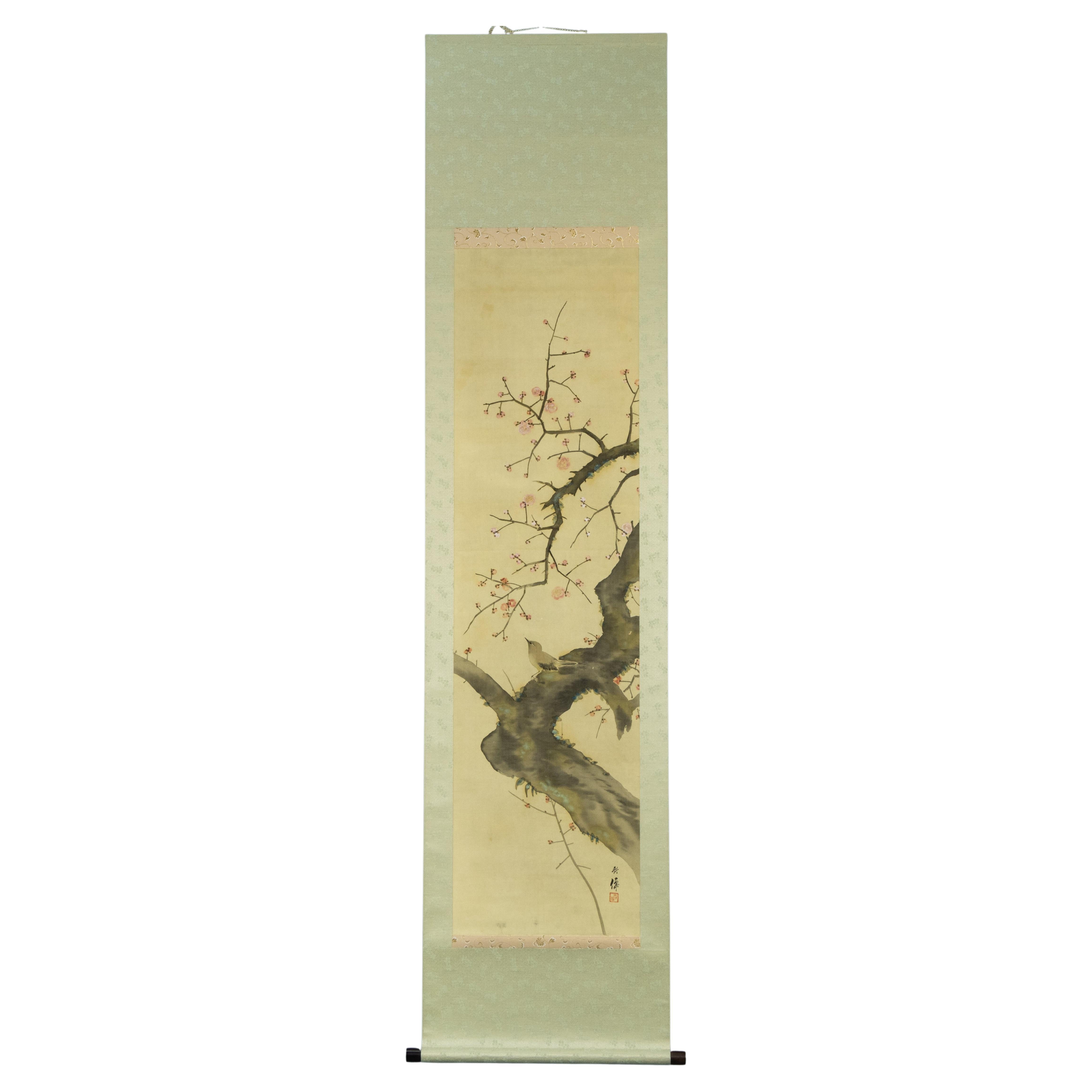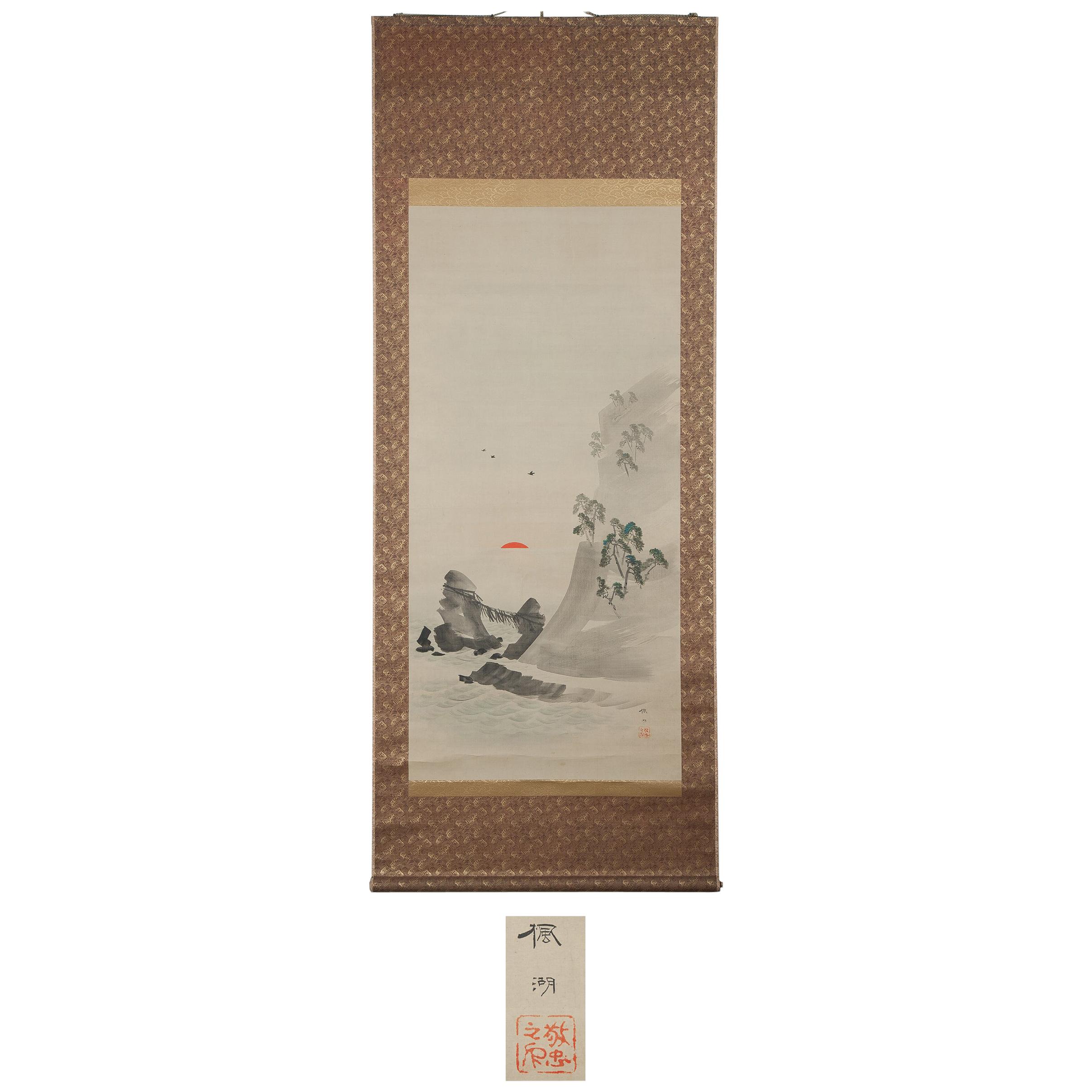Items Similar to Japanese Meiji Riverside Scroll Painting, c. 1900
Want more images or videos?
Request additional images or videos from the seller
1 of 8
Japanese Meiji Riverside Scroll Painting, c. 1900
About the Item
Although western painting was initially embraced during Japan’s Meiji period (1868-1912), artists brought on a revival of traditional painting styles as they sought to create a modern Japanese style with roots in the past. This exquisite hanging scroll demonstrates the preference for soft layering of gray tones with judicious use of color. The landscape is rendered in soft ink washes that subtly distinguish between water, mountain, and sky. The scroll painting illustrates human presence with intricate detail, bringing the grand estate and passenger boat into focus with dark outlines and careful brushstrokes. Delicately composed, this scroll perfectly captures the beauty of Meiji-era landscape painting.
- Dimensions:Height: 85 in (215.9 cm)Width: 23.5 in (59.69 cm)Depth: 1 in (2.54 cm)
- Style:Meiji (Of the Period)
- Materials and Techniques:
- Place of Origin:
- Period:
- Date of Manufacture:circa 1900
- Condition:Wear consistent with age and use.
- Seller Location:Chicago, IL
- Reference Number:

About the Seller
4.9
PAGODA RED is a renowned resource for designers as well as collectors of contemporary and ancient Chinese, Korean and Japanese art. They offer a curated edit of fine and provincial furniture, ceramics, scholars' objects, and paintings and textiles, each piece historically and geographically authentic.
Diamond Seller
These expertly vetted sellers are 1stDibs' most experienced sellers and are rated highest by our customers.
Established in 1997
1stDibs seller since 2006
1,412 sales on 1stDibs
Typical response time: 1 hour
- ShippingRetrieving quote...Ships From: Chicago, IL
- Return PolicyA return for this item may be initiated within 2 days of delivery.
More From This SellerView All
- Japanese Meiji Hanging Scroll of Ayu Fish, c. 1850Located in Chicago, ILAlthough Western painting was initially embraced during Japan’s Meiji period (1868–1912), artists brought on a revival of traditional painting styles as they sought to create a moder...Category
Antique Mid-19th Century Japanese Meiji Paintings and Screens
MaterialsPaper, Silk
- "Literary Gathering" Chinese Scroll Painting, c. 1923Located in Chicago, ILExquisitely painted with delicate line work and a subdued color palette, this Chinese scroll painting is an Late 20th-century reproduction of a...Category
Late 20th Century Chinese Paintings and Screens
MaterialsSilk, Paper
- Taoist Ceremonial Scroll Painting, circa 1870Located in Chicago, ILThis colorful painted scroll is a Taoist ceremonial painting attributed to the Yao or Mien minority culture of southern China, northern Vietnam and other neighboring regions. The sma...Category
Antique Late 19th Century Chinese Qing Paintings
MaterialsPaper
- Chinese New Year Painting, c. 1900Located in Chicago, ILIn celebration of the lunar New Year festival, it was traditional all over China to hang special decorations. In a city called Wuqiang, local artists made lacquer scroll paintings laden with symbolism. This framed and finely rendered early 20th century folk painting from Wuqiang features an imperial court official and his family dressed in their best silks. The young boy is dressed in a wonderfully patterned yellow robe to offer Shou Xing...Category
Early 20th Century Chinese Qing Paintings and Screens
MaterialsPaper
- Chinese Floral Longevity Canopy Painting, c. 1900Located in Chicago, ILThoughts of a long, happy life greeted the young couple who gazed up from their bed on this canopy panel. Adorned with chrysanthemums and peaches, both symbols of longevity, the lyri...Category
Early 20th Century Chinese Qing Paintings and Screens
MaterialsPine, Paint
- Chinese Reverse Glass Painting of Taoist Immortals, c. 1900Located in Chicago, ILPopularized during the Qing dynasty, reverse glass painting requires an artist to essentially work backwards, starting with details and shading before adding color and form. Lending the finished work a subtle three-dimensional effect, this exacting technique doesn't allow for any corrections, and is only revealed to its full effect when the glass pane is turned around. This example dates to the late 19th century and depicts the Taoist immortals He Xiangu and Cao Guojiu. Said to have attained immortality through their studies of the natural world, the Eight Immortals each represent a different condition in life and impart blessings of prosperity and longevity. The charming scene is likely one of a set of...Category
Early 20th Century Chinese Paintings and Screens
MaterialsGlass, Wood
You May Also Like
- Japan Scroll Painting, Meiji PeriodLocated in Pasadena, CAThis is a wonderful example of a Meiji Period screen painting of Japanese Tanuki or racoon dogs in a landscape. The Tanuki is considered to be a mythical creature Japanese culture. T...Category
Antique Late 19th Century Japanese Meiji Paintings and Screens
MaterialsFabric, Paint
- Antique hanging scroll of Japanese cat/Late Edo-Meiji period/Cat paintingLocated in Sammu-shi, ChibaThis is a picture of a cat drawn by a person named "Toshizumi Nitta" from the end of the Edo period to the beginning of the Meiji period. She is a very simple and cute cat. He is a vassal of the Tokugawa Shogunate, born in Ota City, Gunma Prefecture (southern part of Gunma Prefecture). He was related to the Tokugawa family and lived in a large mansion in the Ota clan in Gunma prefecture. However, the Nitta family's territory was very small, and they were by no means a wealthy vassal. He seems to have lived quite poorly. So he painted cats and sold them to people. The Nitta family continued to draw pictures of this cat for four generations. "Nitta toshizumi" is equivalent to the fourth generation. During the Edo period, sericulture was thriving in the Kanto region. Cats were said to be the gods of silkworms, as they drive away mice, the natural enemies of silkworms. It was the Nitta family who drew such a cat on paper, pasted it in the silkworm chamber, and sold it as a mouse repellent. There were also other monks who painted pictures of cats, but the Nitta family in particular was related to the Tokugawa family, so people believed that paintings of cats had special powers. , a lot of paintings...Category
Antique Late 19th Century Japanese Edo Paintings
MaterialsPaper
- Meiji Era, Circa 1900 Japanese Screen Pair, Flowers & Birds of Spring & AutumnLocated in Kyoto, JPFlowers & Birds of Spring and Autumn Unknown artist. Japan. Meiji period, circa 1900. A pair of six-fold screens. Ink, color, gofun and gold leaf on paper. Signed: Gaga S...Category
Antique 1890s Japanese Meiji Paintings and Screens
MaterialsGold Leaf
- Two Antique Japanese Hanging Scroll PaintingsLocated in Atlanta, GATwo Japanese scroll painting depicts scenes from the Tale of Genji (Genji-E), from Edo period. These painting were purchased from Odewara Shoten in the...Category
Antique Early 19th Century Japanese Japonisme Paintings and Screens
MaterialsBrocade, Paper
- Japanese Meiji Period Painting Scroll Nightingale on Branch JapanLocated in Amsterdam, Noord HollandJapanse school Nachtegaal op tak met kersenbloesem Rolschildering / scroll op zijde, houten rollers. A/B 127 x 34.7 / 190 x 45.7 127 x 34.7 / 190 x 45.7Category
Antique Mid-19th Century Japanese Meiji Paintings and Screens
MaterialsSilk
- Lovely Meiji Period Scroll Paintings Japan Meiji Artist Fuko MatsumotoLocated in Amsterdam, Noord HollandFuko Matsumoto, order of the rising sun, Size: Axis, vertical 212.5 cm next to 84.7 cm Painting, vertical 140.8 cm horizontal 66.7cm ? Differs slightly in size. Condition: The state is good, but, wrinkle-thin stain Biography Fuko Matsumoto 1840-1923 Japan painter. Ibaraki prefecture production. Imperial Art Academy member. Fuko was born as the 3rd son of Matsumoto Soan in Kawachi County of Hitachi Province (Now Inashiki City of Ibaraki Prefecture) on September 14 of the 11th year of the Tenpo era. His real given name was Toshiro. In 1853, when Fuko was 14 years old, he went to Edo and studied painting under Oki Ichiga, who was an official painter of Tottori Domain. Ichiga was a painter who studied the Kano, the Rinpa and the Nanpin styles, and was good at expressing flowers & birds in deep colors. Later, Fuko studied painting under Satake Eikai, who was best pupil of Tani Buncho...Category
Antique 19th Century Japanese Meiji Paintings and Screens
MaterialsFabric





